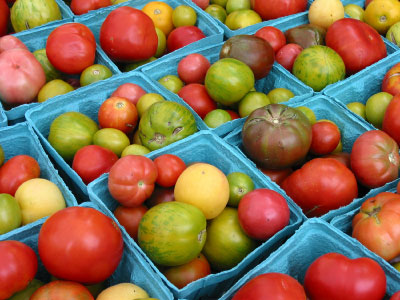by Kim Wilhelm and Bryan Jones of Sweet Corn Organic Nursery
 There is nothing in the world like home-grown tomatoes right off the vine. And once you’ve tried them, you’ll never want to go back to store-bought. Tomato plants are relatively easy to grow too, with just a few tricks.
There is nothing in the world like home-grown tomatoes right off the vine. And once you’ve tried them, you’ll never want to go back to store-bought. Tomato plants are relatively easy to grow too, with just a few tricks.
SOIL PREPARATION:
One of biggest keys to success in organic gardening is the condition of the soil. There needs to be adequate organic matter to hold moisture and nutrients. And at the same time, the soil needs to be loose enough for good aeration and drainage, which will help promote strong root development.
Tomatoes are easy to grow if your soil has the proper nutrients. People always assume their soil is average, but unless you have a soil test it is just a guess. More often than not, it is necessary to amend the soil to achieve optimum pH balances, as well as the proper levels of nitrogen, phosphorus and potash. Testing your soil is ideal, and we recommend a soil test every two to three years to check your phosphorus and pH, as well as nitrate and potassium levels, to ensure the best crop possible. It is very important that your phosphorous to nitrate ratio is correct. Too much nitrates will produce leaves but not fruit. If you aren’t testing your soil, at a bare minimum, before planting anything, work in at least 2-4” of organic mulch and at least one-half inch of finished compost into your topsoil. For tomatoes, make sure you have plenty of phosphorus, bone meal or soft rock phosphorus in your soil. If you suspect your soil is less than ideal and possibly a little low on phosphorus, mix in a cup of Mega-Mator into every 100 sq. ft. of soil. This 100% organic soil amendment has an ample supply of phosphorus and will make up for a lot of deficiencies.
Also, mulching with compost or straw will help keep the soil moist and also help to feed the plant and prevent weeds. Don’t mulch over 3-4″ because this might prevent oxygen from entering the soil and could cause root rot.
PLANTING INSTRUCTIONS:
If planting from seed: When planting tomato seeds, wait until the soil has warmed and nighttime temps are around 58 to 60 degrees, and one week before all frost danger is over. Then plant two or three seeds directly in the soil in full sun. Make each hole 1/4″ deep and space plants 2’ apart. Rows need to be 2-3’ apart when planting determinate types (no staking required), and 3-4’ feet apart when planting indeterminate (staked or caged). When planting in raised beds you can plant as close as 2’ by 2’. Seaweed can be used right away, which will help with germination and builds roots. There is very little nitrates in seaweed, so you won’t burn anything. In fact, we soak seeds in seaweed before planting and we feed every week from that point on. Once seedlings appear, thin to one plant.
If planting seedlings: When plantings seedlings instead of seed, I always put bone meal or Mega-Start in the bottom of the planting hole (you don’t really need to measure, just a good handful of bone). This ensures they will never starve for phosphorus. Also, plant the plants deep enough to where only 3 leaves are showing above ground.
We start our seedlings in Walls of Water, which is a mini greenhouse you fill with water (and will last for 10 years, so it’s the cheapest greenhouse you can buy!). The walls will keep your plant from freezing up to 16 degrees, and also protect your plants from wind. We are at 6400 in elevation in Zone 5, and we can plant April 15th instead of June 7, our normal frost-free date. So, we are eating tomatoes when most people are waiting for their frost date to plant! If you aren’t using walls of water, then you should harden off your seedlings before planting. This is done by placing the seedlings in direct sun for an hour, then placing in the shade. Each following day increase the time in the sun by one hour; repeat this each day until they are in the sun for 6 to 8 hours, which will take a week or so. Make sure they don’t dry out.
If you know there is a chance of hard freeze, bring seedlings inside until freeze is over. When it is safe, leave seedlings outside, placing them next to a building with an overhang and let them get used to nighttime temperatures. The building and overhead cover should give you some protection. After one night outside and they are used to sun, you can plant without shocking the plant. When planting outside without walls of water, plant when outside temperatures may go to 40 degrees but mostly stay above 50 degrees.
If you’re vegan or don’t like to use bone meal, then Mega-Start will work. It’s 100% Organic and animal-free. It is best to root feed with seaweed right after planting to prevent shock. Seaweed is better for shock prevention than any other product on the market.
PROPER WATERING INSTRUCTIONS:
There has been a lot of debate on how to water a tomato plant. Too much and you’ll get fewer tomatoes, not enough and they will crack. The quality of the fruit is defiantly on the line. Here is a system I developed for beginners, which also works for old-timers like myself. First you need to understand the crop. It’s okay to let them dry out between watering when they’re young — to the point where they’re just about to wilt from lack of water. This will produce flower production. They think they’re dying and when they do get watered they go into full flower production. Their whole job is to produce seed for the next generation, so they think “Okay, this is it, the only water I’m going to get” and they kick it into gear. So, don’t over-water in the beginning.
When fruit starts to form you need too count how many days it take for the plant to start to wilt. Lets say it’s 5 days. In that case, your watering schedule will be every 4 days. This will change with weather and outside temps, so adjust accordingly. This way they get just enough with out drying out completely when in fruit production. When fruiting, don’t let them dry out because this is why your tomatoes crack. They store water in their fruit for drought and they will take this water if needed. The tomato shrinks, and then when you water they fill there storage container (tomato) and they burst. I wrote this in a way to give you a different way to look at your plants and try to give you another basic idea of the ART of organic growing.
FERTILIZING/AMENDING:
After plants have first two leaves (about two to three weeks), plants should be fed fish emulsion every two weeks, and sprayed with seaweed on their leaves once a every week during the entire growing season. After flowers first start appearing, apply Mega-Mator to the top of the soil around the base of the plant. As plant continues to grow, apply Mega-Mator further and further away from the stem but within access to the drip line. This should be applied every two weeks for entire growing season, along with fish and seaweed. This will ensure the best-tasting, biggest crop you can grow.
Recommended Schedule for Fertilizing and Amending Soil:
1. Bone Meal or Mega-Start — at planting
2. Seaweed — at planting and once a week
3. Fish Emulsion — every two weeks after planting
4. Mega-Mator — every two weeks
SWEET CORN SECRET:
When planting from seedlings or larger tomato plants, whether you plant in walls of water or wait for your frost date, put in organic phosphorus and plant them very deep — just have three leaves showing on top of the plant. Count the very top as one and the next two leaves showing. If you do this, you will get more roots and more roots, more flowers and more flowers. Which equals more tomatoes! This is very effective with bigger plants. You can take a 12-inch plant and lay it down in the hole sideways and just have the first three leaves coming out of soil, trim off the rest of the leaves, and the whole stock of the plant will root and the plant won’t stunt and become root-bound (which can happen when planting bigger plants).










0 Comments